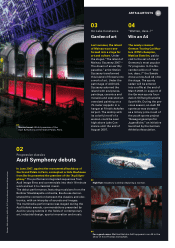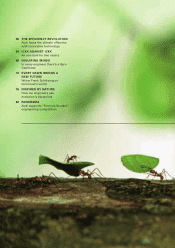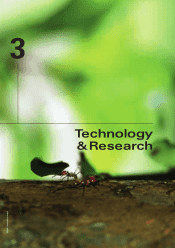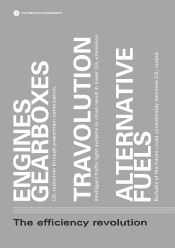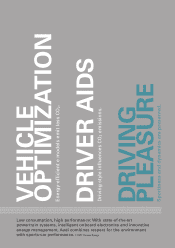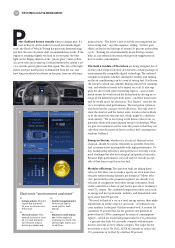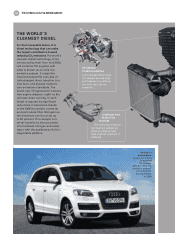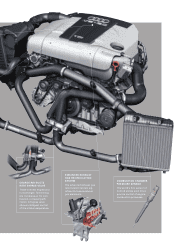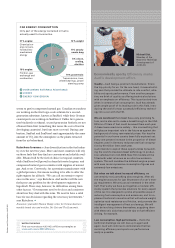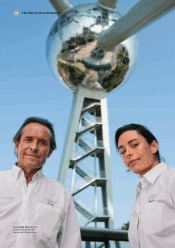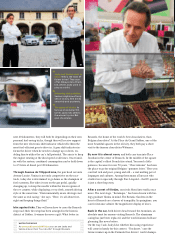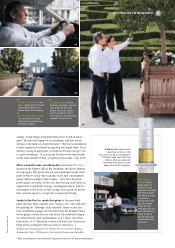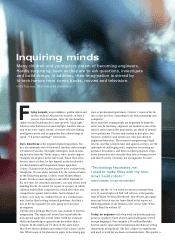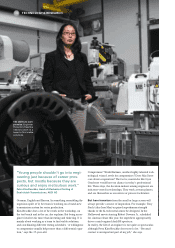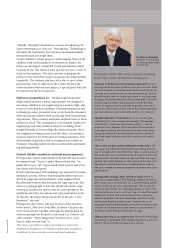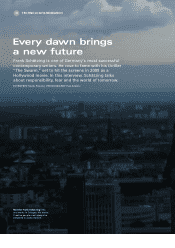Audi 2007 Annual Report Download - page 64
Download and view the complete annual report
Please find page 64 of the 2007 Audi annual report below. You can navigate through the pages in the report by either clicking on the pages listed below, or by using the keyword search tool below to find specific information within the annual report.
Almost 20 years ago, Audi made waves with the hybrid Audi
Duo, although this model did not attract widespread interest
from customers. The car was clearly well ahead of its time.
Today, by contrast, there is widespread discussion about the
pros and cons of hybrid engines. Hybrid technology is just one
of many technical options, and its advantages are particularly
apparent in stop-and-go traffic.
2008 will see the launch of the Audi Q7 with its full hybrid
system which lowers CO2emissions by up to 23 percent as
measured under the New European Driving Cycle. This SUV
will also boast acceleration values that compare very favorably
to those of a sports car. A hybrid engine makes sense for cus-
tomers who mainly drive in cities, and Audi will be making
additional hybrid variants available in the coming years for
these drivers. But it is important to remember one thing: From
a green perspective, economical diesels are clearly superior
when it comes to driving long distances. In the debate on car-
generated CO2emissions, one thing stands out, and that is that
attention centers on a car’s fuel economy and driver behavior.
Immanuel Kutschera adds another crucial factor: “Of course
we need to build efficient cars. But fuel also offers enormous
potential for reducing CO2emissions.”At Audi, Kutschera is
responsible for investigating the potential of alternative fuels.
He is a mechanical engineer, but as terms such as E100, Sun-
Fuel or CNG crop up in Kutschera’s conversation, you might
be forgiven for thinking you were talking to a chemist. A
chemist armed with a map of the world, that is, one which
he uses to show where alternative fuels are already being
used. Brazil, for instance, uses pure bioethanol, while China
for the foreseeable future, it is the diesel which can make
the largest contribution toward reducing CO2emissions.
“From mid-2008, we will be introducing the world’s cleanest
diesel technology as standard,” is how Georg Middelhauve
and Zaccheo Giovanni Pamio proudly put it. The two develop-
ment engineers have played a significant part in ensuring that
TDI engines will be combined with an “ultra low emission
system,” thereby setting a new global standard. Especially
efficient combustion methods and the sophisticated treatment
of exhaust gases with catalytic converters and particulate fil-
ters helped the development engineers to achieve the desired
result: The reduction of CO2exhaust gas and nitrogen oxide
emissions to a level that falls well below all current worldwide
legal limits. This diesel technology has excellent potential for
large growth markets such as the U.S., China and India.
Hybrids with a boost. All this means that development of
gasoline and diesel engines is evolving in the right direction.
Yet Audi is not only a technical trailblazer with its TDI and
TFSI technologies, but also in the field of hybrid engines.
Cars were made for driving, not for standing in traffic
jams. No form of driving is more harmful to the environ-
ment than backups at traffic lights. This is not a new dis-
covery, yet municipal traffic planners have for the most
part failed to ensure a good flow of traffic in their cities up
to now. There are technical reasons for this: Modern traffic
light systems are rather inflexible. Also, progressive signal
systems that let traffic flow on thoroughfares thanks to se-
rialized green lights create no overall benefit if they make
too many cars wait at red lights on neighboring roads. A
joint project between Audi, the Technical University of Mu-
nich and Munich-based IT development company Gevas
Software aims to change all that using “Travolution.” The
name is a contraction of traffic and evolution.
Travolution promises intelligent green light for all. Induc-
tion loops at traffic lights send traffic data to a central
computer. This calculates how heavy the traffic will be in
five minutes’ time, and switches the traffic lights accord-
ingly. Data processing is the biggest technical challenge.
The mass of traffic information is unscrambled using a
highly complex computing model from the field of genet-
ics (the genetic algorithm). Efforts seem to be paying off,
as pilot schemes implemented have shown that Travolu-
tion can considerably reduce travel times.
Travolution combines intelligent traffic light control with
driver information systems. For this, traffic lights will be
fitted with wireless radio circuits that broadcast informa-
tion directly to the vehicles, where an in-car display will
62 TECHNOLOGY& RESEARCH
No more waiting at red lights
“Of course we need to build
efficient cars. But fuel also offers
enormous potential for reducing
CO2emissions.”
Immanuel Kutschera, Head of Pre-Development,
Diesel Engines and Fuel Cells, AUDI AG
inform the driver about 200 meters ahead of the junction
of when he can expect the lights to turn to green, so that
he can adjust his speed accordingly.
“In city centers, this means achievable fuel savings of up
to 15 percent,” says Cornelius Menig, Audi’s project man-
ager. A consortium of European car manufacturers has al-
ready been formed. One of its tasks will be to draw up
communications standards for intelligent traffic light sys-
tems. Introducing intelligent traffic management will ben-
efit drivers and the environment alike. After all, cars were
made for driving, not for standing in traffic jams.
The Travolution pilot scheme: Intelligent traffic signals tell
drivers when the light will change to green.



